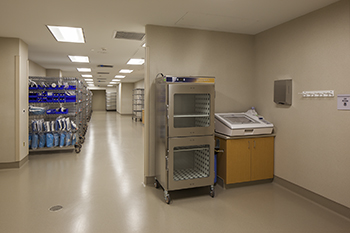Three Strategies to Optimize Your OR: Part 2
 In the optimization of the operating room (OR), every minute counts. Small improvements in OR efficiency over the course of a year add up to a substantial time and cost savings for a health care organization.
In the optimization of the operating room (OR), every minute counts. Small improvements in OR efficiency over the course of a year add up to a substantial time and cost savings for a health care organization.
An estimated 80 percent of surgical cases are completed between the hours of 7:00 a.m. and 3:00 p.m., Monday through Friday. In a blended OR, surgical case predictability ranges from high in the case of outpatient and inpatient visits, to low when it comes to emergency department (ED) or trauma cases. Typically, 60 to 80 percent of surgical cases are outpatient cases and the remaining 20 to 40 percent are inpatient cases – either from the inpatient floors or ED/trauma – requiring immediate surgery.
OR space and operational efficiency is determined by time metrics. Because of their high predictability, surgical managers are best able to quantify and schedule outpatient cases on a daily basis, even when they are same-day admits.
Part one of this article discussed how efficient staffing and block scheduling can help make every OR minute count. This article, part two, will focus on how the standardization of OR equipment, supplies and technology as well as the optimization of the department’s layout can also contribute to improvements in OR efficiency.
Standardization of Equipment, Supplies, Technology & Layout
Standardization of equipment, supplies, technology and layout is another strategy to optimize the OR. Even if the OR is running at peak capacity and surgical staff are well aligned with the volume and types of cases, OR teams must be supplied with the exact quantity, type and preferred equipment for every procedure.
Therein lie the challenges. Some expensive equipment has a limited inventory and must be used immediately by another surgeon for a subsequent procedure, so scheduling can be tight. Physician preference cards for supplies inventory reflect more than mere preferences; the absence of the tools and supplies with which the physician is most familiar, comfortable and skilled can slow down a procedure. Having a tool like inventory software could really help manage stock, as those in charge of it would be able to spot when something is running low and order supplies to make sure that they don’t run the risk of running out of a particular item.
Management of block schedules and preference cards is a daily challenge; however, equipment and supply inefficiencies can compound cost increases from block scheduling to staffing inefficiencies.
The solution lies in standardization of equipment and supplies to the greatest extent possible while satisfying physician preferences. The case for standardization is best supported by presenting inventory and cost data to the surgeons’ council so that they understand that unused inventory equals dollars lost. Most physicians do not have a direct financial stake within a hospital based surgery department, but savings from standardization can benefit them by decreasing average procedure times and reducing staffing inefficiencies such as hunting for missing instruments or preferred supplies. When equipment and supplies are standardized by procedure, staff can load case carts for each OR – ideally, the night before – with supply packets for the next day and place them outside each OR. The efficient flow of the packing and delivery processes is critically important.
Standardization using modern OR technology and physical layout have even broader effects – not only improving efficiency and reducing costs, but also improving ergonomics and reducing employee fatigue, accidents and injuries. Standardization of the physical layout uses a space strategy based on concentric circles: a clean core for sterilized equipment surrounded by ORs and an outer ring comprised of stretcher holding bays, scrub alcoves and support spaces. This strategy reduces flashing because sterilized, standard equipment is always available from the clean core. Surgeons can also move from one OR to another once they’ve scrubbed in to the clean zone. Further benefits can be achieved by standardizing the layout by surgical subspecialty, enabling surgical teams to operate more efficiently.
Standardization in equipment and supply and physical layout enables the surgical team to streamline its procedures, which not only saves money, but also increases patient outcomes and staff satisfaction.
How much does one minute of OR time cost? While it’s difficult to calculate a definitive dollar-per-minute figure, one thing is certain: Every minute counts. Improvements in staffing and block scheduling efficiencies, the standardization of OR equipment, supplies and technology, and optimization of the department’s layout are proven strategies to make every minute count.
As director of strategy at FreemanWhite, a health care consulting and design firm based in Charlotte, N.C., Michelle Mader collaborates with health care leaders to achieve high-level performance and to identify profitable market opportunities.
